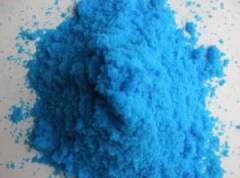Difference between revisions of "Copper Sulfate"
m (→Shipment / Storage) |
|||
| Line 18: | Line 18: | ||
(Other) uses: agriculture (soil additive, pesticides), feed additive, germicides, textile mordant, [[leather]] industry, [[pigments]], electric batteries, electroplated coatings, copper salts, re-agent in analytical chemistry, medicine, wood preservative, preservation of pulp wood and ground pulp, process engraving and lithography, ore flotation, petroleum industry, synthetic rubber, steel manufacture, treatment of natural asphalts.<br><br> | (Other) uses: agriculture (soil additive, pesticides), feed additive, germicides, textile mordant, [[leather]] industry, [[pigments]], electric batteries, electroplated coatings, copper salts, re-agent in analytical chemistry, medicine, wood preservative, preservation of pulp wood and ground pulp, process engraving and lithography, ore flotation, petroleum industry, synthetic rubber, steel manufacture, treatment of natural asphalts.<br><br> | ||
==Shipment / Storage== | ==Shipment / Storage== | ||
| − | [[Copper sulphate]] comprises blue crystals or powder, usually shipped in multiwall paper sacks or drums. Effloresces slowly on exposure to air. Is soluble in water, and if in | + | [[Copper sulphate]] comprises blue crystals or powder, usually shipped in multiwall paper sacks or drums. Effloresces slowly on exposure to air. Is soluble in water, and if in contact with any volume of water, to the extent that it dissolves, will have a corrosive effect on other cargo, especially steel, steel drums, etc. Crystals may cause damage to bags, with leakage and loss of weight. Copper sulfate should be kept well away from other cargo.<br><br> |
The product is highly corrosive, poisonous and soluble in water. The fumes given off if wetted or damp attack other articles in the vicinity and corrode the hoops binding the packaging. Dry stowage remote from edible goods.<br><br> | The product is highly corrosive, poisonous and soluble in water. The fumes given off if wetted or damp attack other articles in the vicinity and corrode the hoops binding the packaging. Dry stowage remote from edible goods.<br><br> | ||
| + | |||
==Risk factors== | ==Risk factors== | ||
Toxic by ingestion , strong irritant.<br><br> | Toxic by ingestion , strong irritant.<br><br> | ||
Latest revision as of 12:32, 13 January 2021
| Infobox on Copper Sulfate | |
|---|---|
| Example of Copper Sulfate |  |
| Facts | |
| Origin | |
| Stowage factor (in m3/t) | 1,53 m3/t (barrels) |
| Humidity / moisture | - |
| Ventilation | - |
| Risk factors | See text |
Copper Sulfate
Description
Copper sulfate is produced industrially by treating copper metal with hot concentrated sulfuric acid or its oxides with dilute sulfuric acid. For laboratory use, copper sulfate is usually purchased.
The anhydrous form occurs as a rare mineral known as chalcocyanite. The hydrated copper sulfate occurs in nature as chalcanthite (pentahydrate), and two more rare ones: bonattite (trihydrate) and boothite (heptahydrate).
Its blue color is due to water of hydration. When heated in an open flame the crystals are dehydrated and turn grayish-white.
Copper sulfate reacts with concentrated hydrochloric acid very strongly. In the reaction the blue solution of copper turns green, due to the formation of tetrachlorocuprate.
Application
Copper sulfate, as the most common copper compound, has many uses. It can be used to kill algae and fungi. Some fungi can get resistant to copper sulfate, though. Then the copper sulfate does not kill them any more. It can be mixed with lime to make a similar fungi killer. It can be used to treat aquarium fish for infections. It is also used to detect sugars. It turns into red copper oxide when reduced by a sugar. It can be used in organic chemistry as a catalyst and oxidizing agent. It is used to see whether blood is anemic.
It is commonly found in chemistry sets. It is used to demonstrate a displacement reaction, where a metal reacts with copper sulfate to make copper and the metal sulfate. It is also used to demonstrate hydrated and anhydrous chemicals.
It can be used to purify copper. A thin pure piece of copper and a thick impure piece of copper are placed in copper sulfate solution. The thin plate is connected to the negative wire and the thick plate to the positive wire. An electrical current is passed through them. The copper in the thick plate dissolves and plates on the thin plate. All of the impurities fall to the bottom, while the pure copper is made at the negative electrode.
(Other) uses: agriculture (soil additive, pesticides), feed additive, germicides, textile mordant, leather industry, pigments, electric batteries, electroplated coatings, copper salts, re-agent in analytical chemistry, medicine, wood preservative, preservation of pulp wood and ground pulp, process engraving and lithography, ore flotation, petroleum industry, synthetic rubber, steel manufacture, treatment of natural asphalts.
Shipment / Storage
Copper sulphate comprises blue crystals or powder, usually shipped in multiwall paper sacks or drums. Effloresces slowly on exposure to air. Is soluble in water, and if in contact with any volume of water, to the extent that it dissolves, will have a corrosive effect on other cargo, especially steel, steel drums, etc. Crystals may cause damage to bags, with leakage and loss of weight. Copper sulfate should be kept well away from other cargo.
The product is highly corrosive, poisonous and soluble in water. The fumes given off if wetted or damp attack other articles in the vicinity and corrode the hoops binding the packaging. Dry stowage remote from edible goods.
Risk factors
Toxic by ingestion , strong irritant.
See IMDG Code and MSDS sheet.











